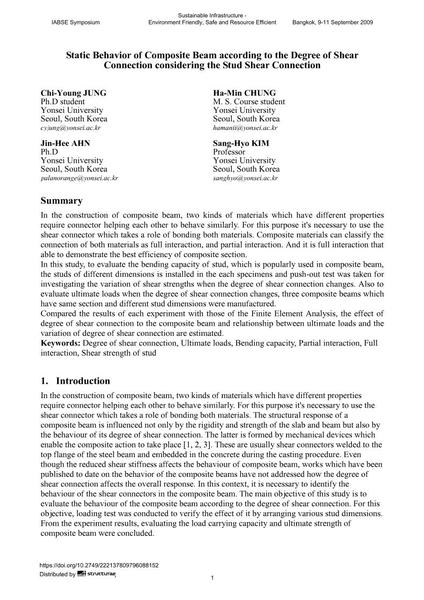Static Behavior of Composite Beam according to the Degree of Shear Connection considering the Stud Shear Connection

|
|
|||||||||||
Détails bibliographiques
| Auteur(s): |
Chi-Young Jung
Ha-Min Chung Jin-Hee Ahn Sang-Hyo Kim |
||||
|---|---|---|---|---|---|
| Médium: | papier de conférence | ||||
| Langue(s): | anglais | ||||
| Conférence: | IABSE Symposium: Sustainable Infrastructure - Environment Friendly, Safe and Resource Efficient, Bangkok, Thailand, 9-11 September 2009 | ||||
| Publié dans: | IABSE Symposium Bangkok 2009 | ||||
|
|||||
| Page(s): | 136-145 | ||||
| Nombre total de pages (du PDF): | 8 | ||||
| Année: | 2009 | ||||
| DOI: | 10.2749/222137809796088152 | ||||
| Abstrait: |
In the construction of composite beam, two kinds of materials which have different properties require connector helping each other to behave similarly. For this purpose it's necessary to use the shear connector which takes a role of bonding both materials. Composite materials can classify the connection of both materials as full interaction, and partial interaction. And it is full interaction that able to demonstrate the best efficiency of composite section. In this study, to evaluate the bending capacity of stud, which is popularly used in composite beam, the studs of different dimensions is installed in the each specimens and push-out test was taken for investigating the variation of shear strengths when the degree of shear connection changes. Also to evaluate ultimate loads when the degree of shear connection changes, three composite beams which have same section and different stud dimensions were manufactured. Compared the results of each experiment with those of the Finite Element Analysis, the effect of degree of shear connection to the composite beam and relationship between ultimate loads and the variation of degree of shear connection are estimated. |
||||
